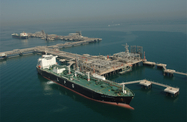While lower prices may limit new investments in Oman’s upstream energy sector, Iran’s return to international markets is likely to have a mixed effect on the sultanate’s economy.
Despite the greater downward pressure on oil prices expected in the medium term due to higher supply, Oman’s non-oil economy and bilateral trade with Iran could see a boost from the lifting of sanctions.
Market dynamics
Oman’s economy is set to post strong growth this year, the IMF reported in May, though lower energy revenues could temper expansion further down the line. “The decline in oil prices is expected to push Oman’s fiscal and external current account balances to deficits from 2014/15 and keep them in double digits as a percent of GDP over the medium term,” the report said.
While oil production has increased in recent months, with output reaching 992,724 barrels per day (bpd) in June, up 1.8% on the month, and exports rising 11.3% to 27.36m barrels, according to the Ministry of Oil and Gas, this has not been enough to counter the downturn in global prices.
According to a report issued by the Central Bank of Oman (CBO) at the end of June, the hydrocarbons industry’s contribution to the economy fell from 52.3% of nominal GDP in 2012 and 50.6% in 2013 to 47.2% last year.
Taking stock
Although high costs and modest returns on certain fields have seen some international firms take a step back, local player Oman Oil Company Exploration and Production (OOCEP) is moving ahead with its exploration efforts.
In June, Ireland-based oil and gas exploration firm Circle Oil announced it was withdrawing from Oman, relinquishing the two leases it held and writing off its investment, in an effort to rationalise costs in the face of weaker oil prices. Circle Oil had held the rights to onshore exploration Block 49 and offshore Block 52 in the south of the country.
Meanwhile, in mid-July, OOCEP announced it was proceeding with exploration and research work on Block 60, located in central Oman. Though the concession is relatively small, at 1580 sq km, the company said initial testing showed significant promise. Block 60 already has one major field in operation, OOCEP’s Abu Butabul tight gas project, which came on-line in December after $1.2bn worth of investment.
Back in the neighbourhood
The sultanate’s oil industry is likely to be impacted by any return by Iran to global oil markets. In mid-July, Bijan Namdar Zanganeh, Iran’s minister of oil, announced the country’s plans to scale production up to 4m bpd within seven months and 4.7m bpd thereafter in a bid to recover market share lost under the sanctions regime. In 2014 Iranian exports fell to an average of 1.4m bpd, according to data from the US Energy Information Administration, just over half of daily sales before trade restrictions were tightened in 2011.
Given Oman’s relatively high break-even price, at $108 per barrel last year, greater supply could create further downward pressure on prices and serve as a disincentive for investments in capital-intensive industry practices like enhanced oil recovery.
Bright spot
In non-oil terms, however, Iran’s return to the international stage presents a variety of opportunities for Oman, in line with the sultanate’s broader diversification efforts. According to IMF figures, non-oil GDP growth in Oman outpaced the broader economy by a factor of two in 2014, up 6.5% on the year.
Steffen Dyck, a senior analyst at Moody’s, told local press, “Growth in Oman-Iran bilateral trade would probably increase relatively quickly once sanctions are lifted, given the geographical proximity and historical ties,” highlighting services exports, such as travel, logistics, finance and communications, as key avenues for growth.
According to local media, trade between the two countries hit the $1bn mark in 2014, a significant increase over an average of just $200m in recent years, while Iranian investment in the industrial zones at Sohar and Duqm stood at around $4bn.
In particular, analysts highlight opportunities for Oman’s ports as centres for re-export of Iranian goods to the region and beyond, with a direct shipping lane agreement between the two countries signed in April and the first Iranian ship arriving at the Port of Sohar in late May.

